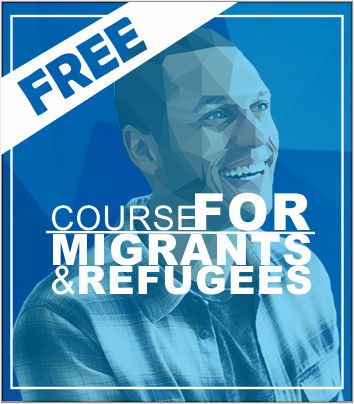This course is intended to serve as a guidance tool for migrants who wish to live, work, and settle in a new society, as well as to provide support to professionals from social organizations that conduct reception and counseling tasks for foreign non-EU citizens.
The content is aimed at people who are under immigration laws, and has been made thanks to the joint work of volunteers and experts. It explains the duties and rights of both newcomers and the authorities in all areas; in general terms, it aims to contribute to the inclusion of migrants and refugees, including more specific materials on some of the areas. However, for a personalized information and advice, we recommend contacting a legal service and/or a specialized entity.
The contact data of all public entities cited throughout the guide in each area are in the last pages of each of the didactic units, plus a brief list of associations that can provide you legal advice, guidance, and other services aimed at the migrant population.
One of the more useful objectives of the course “SPECIFIC PROFESSIONAL TRAINING” is to obtain, once completed, a certificate recognized by the entities participating in the project, designed under the European Erasmus Plus Programme. This provides information on the different inclusion mechanisms, while also providing resources for the real improvement of the situation of the migrant person.
Basic information
| Number of Didactic Units: | 12 |
| Number of downloadable materials: | 2 |
| Estimated number of hours to complete the course: | 279 |
| Number of pages of downloadable material: | 250 |
| Number of languages: | 3 |
Curriculum of the course
1: WHAT IS THIS COURSE FOR?
| 1.1. Objectives of this course |
| 1.2. Characteristics of this course |
| 1.3. Quality and certification systems of the course |
2: EUROPEAN HISTORIC AND CULTURAL CONTEXT
| 2.1. What is Europe’s reaction historically to migrants and refugees? |
| 2.2 How will my reception in Europe be today ?: The migration crisis |
3: BÁSIC NOTIONS ON LEGISLATIÓN
| 3.1 Things you should know about European migration laws, asylum, and refugees |
| 3.2 Things you should know about state legislation regarding migration, asylum and refugees |
4: THE SOCIAL INCLUSIÓN OF THE MIGRANT PERSON
| 4.1. How can social entities help your inclusion? |
| 4.2. How can you start achieving social inclusion and creating networks of friendship, solidarity and help with your new neighbors? |
| 4.3. What difficulties are you going to find regarding social inclusion in your new environment? |
| 4.4. How can you help the social construction of your host environment? |
| 4.5. Innovative experiences for the social inclusion of migrants. |
5: LINGÜISTIC INCLUSIÓN
| 5.1. Basic Catalan learning. |
| 5.2. Basic English Learning. |
| 5.3. Basic Spanish learning. |
6: THE EDUCATIONAL INCLUSIÓN OF MIGRANT STUDENTS
| 6.1. How is the education system structured in the participating countries? |
| 6.2. How many migrant students are there, and how will you or your children be received in the education system? |
| 6.3. What difficulties will you find in the classroom? The inclusion of migrants in the classroom. |
| 6.4. Basic registration paperwork, procedures and requirements |
| 6.5. Additional resources |
7: THE MEDICAL INCLUSION OF MIGRANTS
| 7.1. How is the European health system structured? |
| 7.2. What rights do you have in terms of health and what procedures will you require to access them? |
8: PRACTICAL ISSUES ON HOUSING
| 8.1. Basic concepts about rent |
| 8.2. The contract: rights and obligations |
| 8.3. End of the contract: voluntary termination or eviction |
| 8.4. Problems and solutions to rent a house |
| 8.5. Resources |
9: PROCESS OF REGULACION OF THE MIGRANT PERSON
| 9.1. What documents do I have to have in order? |
| 9.2. What is the census registry? |
| 9.3. What is residence and how to achieve it. |
10: THE MIGRANT WOMAN
| 10.1. Basic rights. |
| 10.2. Specific resources |
| 10.3 Gender violence |
11: LABOR INCLUSION
| 11.1 Basic notions |
| 11.2. Curriculum vitae |
| 11.3. Resources |
12: THE ERASMUS PLUS PROGRAMME
| 12.1 What is the Erasmus Plus Programme |
| 12.2 Objectives of the Programme |
| 12.3 Who can participate? |
| 12.4 Who manages the Erasmus Plus Programme? |
| |






